You are here: Cops>Common Web>NewsMedia>M1595 (24 Dec 2017, RaymondLutz)Edit Attach
Independent Review of the Seralini GMO-Roundup Rat Study
Citizens Oversight (2015-05-30) Ray Lutz This Page: https://copswiki.org/Common/M1595More Info: Gmo Open Forum, March Against Monsanto
Introduction
A lot as been said about the "Seralini Rat Study" AKA "Long term toxicity of a Roundup herbicide and a Roundup-tolerant genetically modified maize", published in the Peer-reviewed journal "Food and Chemical Toxicology" Volume 50, Issue 11, November 2012, Pages 4221-4231. This research was first approved, then retracted after the journal received a great deal of pressure to do so by the pro-GMO industry. Here, I will attempt a reasonable high-level review of the article and also the related "Hammond" research of 2004 which prompted the Seralini study.-
 (M1592) 2014-06-25 Study on genetically modified corn, herbicide and tumors reignites controversy -- , Cbs News,
(M1592) 2014-06-25 Study on genetically modified corn, herbicide and tumors reignites controversy -- , Cbs News,
Showing that something will not happen
It is difficult to "prove" that something will not happen. But there are standard practices to show that it is unlikely to happen using sampling inspections and testing. These methods are well understood and used everyday, but seem to be misinterpreted here. If nothing happens, you have to make sure your sample size is large enough to show that you actually tested enough units to get past the sampling error issue. If you do get failures with small samples sizes, then it depends on how many, and you may have to increase your sample size to validate the result.The Hammond Study
It is going to be useful to first review the Hammond Study of 2004 because this is the precursor of the Seralini study. This study was to assess the safety of GMO corn when fed to rats over a 90-day period. Here is the full text of the Hammond study report: Hammond_et_al_2004.pdf The test animals: Male and female Sprague–Dawley derived rats (Crl:CD 1(SD)IGS BR) from Charles River Laboratories (Raleigh, NC) were approximately 6 weeks of age at study start. The first curious thing about this study is the large number of control groups compared with the number of treatment groups. There were two treatment groups, one getting 11% GMO corn in their food and the other getting 33%. Each treatment group included 40 rats, 20 of each sex. 80% of the rats were in control groups while only 20% were in treatment groups, and only 10% (40 rats out of the 400) were fed food with 33% GMO corn.- Hammond - Treatment Groups:
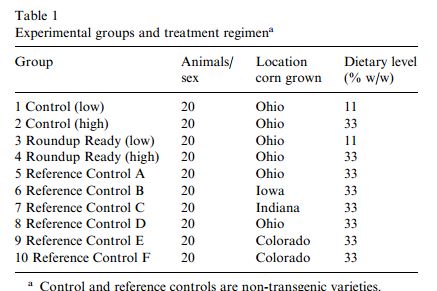
But the corn did not have any glyphosate. This seems a bit artificial. Although they say it was grown using Round Up, it would seem that some residue would exist either on the surface or internal to the plant. This is a big contrast with the Seralini study which did include glyphosate at levels not exceeding those actually found in practice.
Very importantly, the Hammond study resulted in an early fatality of one male rat, almost at the end of the 90-day period.
Without any real reason for doing so, they say this fatality has nothing to do with the GMO diet. This is a big jump and I can't imagine that everyone in the industry did not worry about why this death occurred, and called therefore for more testing. Given the very small size of the high-dosage treatment group (only 10% of the lot) to have a death ONLY in this group is warrants more than the simple brush off they give it. This is a very big problem with this study, not so much that it happened, but because the experimenters ignored the results and promoted their research as showing that GMO corn was safe. In all honesty, you can't disregard that dead rat. It is not "missing data." It is the most important data point, signifying that GMO corn may be VERY dangerous indeed.

They also noticed that the urine chemistry of male rats had changed but was "within two standard deviations" of the control groups. But that could be significant and given the small size of the high-dosage treatment group (only 10% got 33% GMO food), this is cause for concern, but they decide to ignore it.

Later, Hammond goes into a great deal of time and space to compare their study with other studies and to paint a picture that everything is fine, while dedicating almost no time to explain the huge problem of the dead rat. Such a review of other studies may be common, but is not required in a technical article documenting a study. Since almost no time was spent to explain the death, and as this is not in the abstract either, this underlines that they definitely wanted to help the reader reach a conclusion that GMO crops were safe. But as we continue to read, they also say that the concern is reduced because the percentage of crops that are GMO is low and so the feed is not concentrated. This whole passage leads one to believe that there really is a risk in eating too much GMO food. This is coupled with the fact that they did not find a reason for the dead rat, or perhaps they actively elected to suppress that information. Giving them the benefit of the doubt, it may be that the mechanism of death was simply not apparent using the inspection techniques used.
After looking over this study, there are some red flags:
- Glyphosate (and related roundup ingredients) not at all on/in the food. This is artificial.
- Many control groups (8) and very few (2) treatment groups -- only 10% at the high dosage.
- standard practice is to have three dosage levels and an equal or perhaps double size control group. Thus the control group would be 20% to 40% of the total subjects rather than 80%.
- Dosage limited to 33%. Why not have the rats eat 100% GMO food?
- A fatality in the high-dosage test group that is blown off as nothing.
- Changes in urine chemistry of the high-dosage test group is blown off as nothing because it is "within two standard deviations" of the control groups. Anything more than 1 standard deviation is outside the "normal" region. That's why they call it the standard deviation.
- Extensive review of other studies within the study document... this is out of line and a distraction, but may indicate that they were pushing for an overall result.
- Precautionary text at the end which explains that the "risk" is further reduced.
- EPA-HQ-OPPT-2009-0156-0010-90-day-oral-toxicity-in-rodents.pdf: EPA standards for toxicology tests in rodents
- EPA requires 20 rodents in each group, 10 males, 10 females:
- EPA requires 1 control group apparently of the same size as other groups:
The Seralini Study
With that as background, we move to the Seralini study. Although retracted, the study report is available and you can read it at this link:- RetractedSeraliniStudyReport.pdf: Retracted Seralini Study Report.
Although there is some consternation about the type of rats used, they are the same as those used in the Hammond study: "Virgin albino Sprague-Dawley rats at 5 weeks of age were obtained from Harlan (Gannat, France)." The Seralini report also commented on the number of rats per group, and the existence of a control group. Seralini used three dosage levels, 11%, 22%, and 33%. They used groups of 20 rats each, with 10 males and 10 females, at various dosages and food compositions, and one control group.
- Seralini -- Comment on Rats per Group:
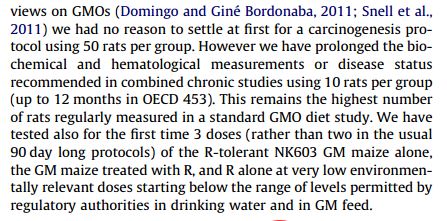
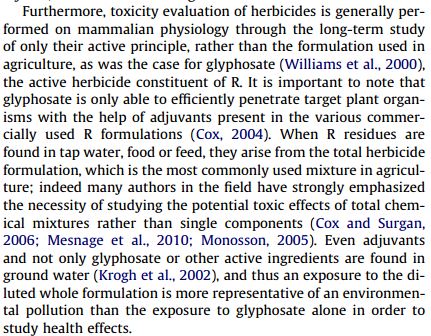 The food used in the Seralini study is more like the real world. The Hammond Study did not include any Roundup R in the food, while the Seralini study did, although it states, "with no contaminating pesticides over the standard limits." Also, there is some glyphosate dissolved in drinking water, about what is expected in the environment.
The food used in the Seralini study is more like the real world. The Hammond Study did not include any Roundup R in the food, while the Seralini study did, although it states, "with no contaminating pesticides over the standard limits." Also, there is some glyphosate dissolved in drinking water, about what is expected in the environment. 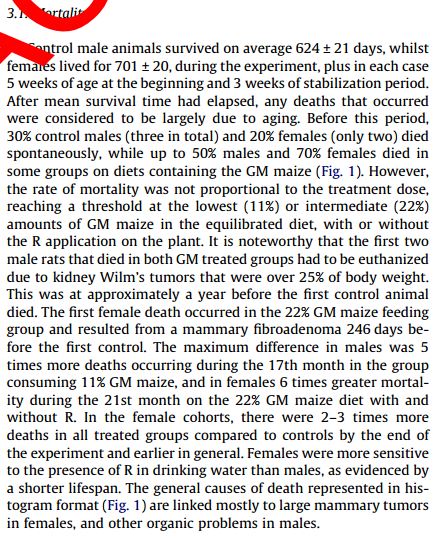 And interestingly, the results were not proportional to the GMO dosage in the food. It seems getting any at all was a problem
And interestingly, the results were not proportional to the GMO dosage in the food. It seems getting any at all was a problem- Typical Long Term Study Design:
- Dosage, from Principles and Methods of Toxicology, pg 340:
Conclusion
Although the Seralini study could have been improved with 5x more rats in each study group, the results are so startling and clearcut, that increasing the numbers will hardly make the effect go away. A new follow-on study could easily be done with 50 rats of each sex in each study group and a larger control group. But this concern is only merited if there were no real differences between the groups at all. That is the time you need to up the numbers. If any study had too few test animals, it was the Hammond study, with 80% of the rats in control groups, and only 10% in a high-dosage test group, and that was only at 33% GMO food. And even with their super-biased study design, they had an early fatality and ignored it as nothing. It is clear to me that the scientific community in the GMO field has been captured by the industry where it is almost professional suicide to posit that GMO crops and the associated hericides are dangerous. These studies indicate that there is reason for concern.The Study we need
The science that should be done at this point is a similar study to the Seralini study, but with 100%, 50% and 10% GMO food, glyphosate (and other Round Up constituent) residue, with 100 rats in each dosage, and a control group with 200 rats. (all groups with sexes evenly represented.) If the rats show any problem (i.e. difference from the control groups) I assert such GMO food and round up should be systematically pulled from use.The GRACE study
The GMO Skepti-forum (GMOSF) responded to this review by noting that the EU has started a new study "Ninety‑day oral toxicity studies on two genetically modified maize MON810 varieties in Wistar Han RCC rats (EU 7th Framework Programme project GRACE)". First of all, this study does not propose a two-year study, but only a 90-day study, although there is perhaps some other effort to also do a longer study.- GRACE-FeedingTrials_AB_ArchToxicol_2014.pdf: GRACE Study: Ninety‑day oral toxicity studies on two genetically modified maize MON810 varieties in Wistar Han RCC rats (EU 7th Framework Programme project GRACE)"
- GRACE study dials down the number of animals per group, then rounds down.:
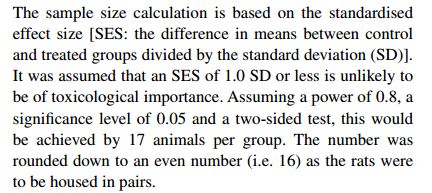
- See this page: http://www.3rs-reduction.co.uk/html/6__power_and_sample_size.html
- Sample Size by Power Analysis:
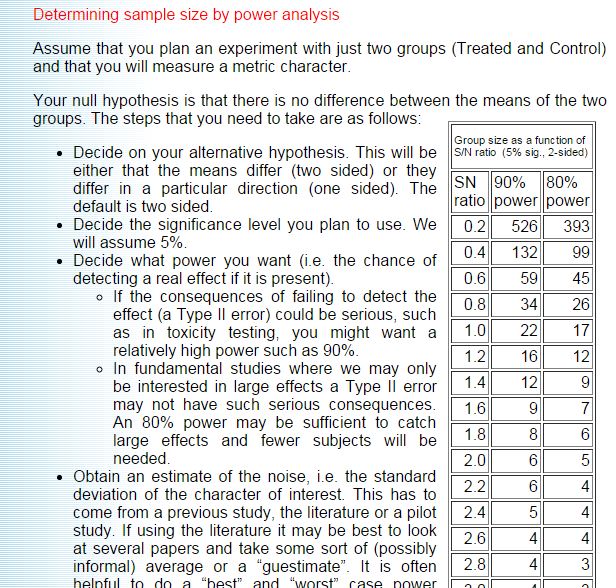
- Note that they recommend that in toxicology, they recommend a power of 90%.
- To select the proper "minimum" number, you need to know the standard deviation of the effect, so as to determine the Signal to Noise ratio.
- We already saw an unexplained death in the Hammond study, and they also had a rat that had to be euthanized due to a broken nose. These things happen with live animals. We need a bit of a buffer between the absolute minimum number and the actual number used.
- It is prudent to include additional numbers in the study to avoid any claim that the study is invalid.
- Hammond had 20 animals per sex per study group. This test should be at least as strong.
- It does not include three dosage levels. There is a claim that dosage is irrelevant. That fact is very important if true. It would mean that we should avoid all contact with GMO foods to avoid the risk, Thus this study protocol should include three levels.
- We are concerned that the highest dosage of GMO food is only 33%. The argument that it is unhealthy to feed the rats 100% corn, regardless of whether it is GMO.
- Standard laboratory rodent meal is described here: http://www.labdiet.com/cs/groups/lolweb/@labdiet/documents/web_content/mdrf/mdi4/~edisp/ducm04_028021.pdf
- Ingredients of Lab Rodent Meal, typical, from Lab Diet.com:

- It includes, as the primary ingredient, soy meal. Thus the level of GMO in the rodent diet should be dialed up by replacing BOTH corn and soy. This should be at least 66% of the meal because soy is the primary ingredient.
- GRACE does not use Round up during the cultivation of the crops. This is an artificial removal of any glyphosate and related products from the corn, and makes the study nearly worthless. Thus, this study does not directly address the issues addressed by HAMMOND and certainly not that addressed by Seralini.
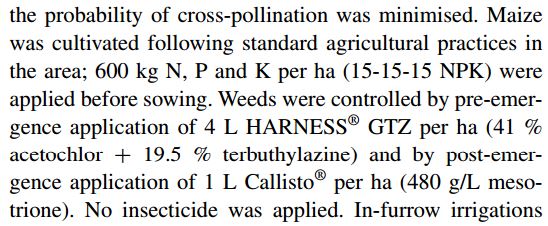
GMO Skeptic Forum
This was posted on the GMO skeptic forum at this link: https://www.facebook.com/groups/GMOSF/permalink/569899966482591/ Out of rudeness, they placed the link in the "Explanations for a 5 year old" and then banned me from the group, they said because"Ray, I regret to inform you that you have been removed from the GMO Skepti-forum for failing to provide evidence that Chad Niederhuth was requesting. If you choose to return to GMO Skepti-Forums, you will need to provide this evidence via PM to me and we will go from there. Evidence required >>> I am going to call you out right now. Provide evidence that 16 rats per sex per group is less than the minimum required for normal oral acute toxicity studies. If you cannot, then admit that GRACE has enough power
Media Form edit
| Title | Independent Review of the Seralini GMO-Roundup Rat Study |
| Publisher | Citizens Oversight |
| Author | Ray Lutz |
| Pub Date | 2015-05-30 |
| Media Link | |
| Remote Link | |
| Embed HTML | |
| Forum Link | https://www.facebook.com/groups/gmoopenforum/permalink/477588802409550/ |
| Note | |
| Keywords | Gmo Open Forum, March Against Monsanto |
| Related Keywords | |
| Media Type | Article |
| Media Group | News, Research, Blog Entry |
| Curator Rating | Plain |
| Venue | |
| Book ISBN | |
| Author Name Sortable | |
| Thumbnail Link |
| I | Attachment | Action | Size | Date | Who | Comment |
|---|---|---|---|---|---|---|
| |
Dosage,_from_Principles_and_Methods_of_Toxicology,_5th_Ed,_pg_340.JPG | manage | 36 K | 31 May 2015 - 01:57 | Raymond Lutz | Dosage, from Principles and Methods of Toxicology, pg 340 |
| |
EPA-HQ-OPPT-2009-0156-0010-90-day-oral-toxicity-in-rodents.pdf | manage | 31 K | 30 May 2015 - 23:55 | Raymond Lutz | EPA standards for toxicology tests in rodents |
| |
EPA-one_control_group_required.JPG | manage | 51 K | 31 May 2015 - 00:01 | Raymond Lutz | EPA requires 1 control group apparently of the same size as other groups |
| |
EPA_standards_on_numbers_of_animals_for_90-day_toxicology_test.JPG | manage | 19 K | 31 May 2015 - 00:00 | Raymond Lutz | EPA requires 20 rodents in each group, 10 males, 10 females |
| |
GRACE-FeedingTrials_AB_ArchToxicol_2014.pdf | manage | 1 MB | 31 May 2015 - 18:55 | Raymond Lutz | GRACE Study: Ninety‑day oral toxicity studies on two genetically modified maize MON810 varieties in Wistar Han RCC rats (EU 7th Framework Programme project GRACE)" |
| |
GRACE-NoRoundUpUsed.jpg | manage | 55 K | 31 May 2015 - 19:15 | Raymond Lutz | GRACE study does not apply Round Up to RR crops. |
| |
Hammond-DietaryExposure-ExtraptoHuman-BasedOnPercentCrops.JPG | manage | 86 K | 31 May 2015 - 01:56 | Raymond Lutz | Hammond - Explains that low percentage of crops makes it safe |
| |
Hammond-FoodForTest.JPG | manage | 50 K | 30 May 2015 - 23:41 | Raymond Lutz | Hammond - Food for Test |
| |
Hammond-NeitherDeathConsideredTestArticleRelated-Why.jpg | manage | 13 K | 30 May 2015 - 23:51 | Raymond Lutz | Hammond - Ignores the dead male rat. |
| |
Hammond-NoglyphosateInDiets.JPG | manage | 23 K | 30 May 2015 - 23:48 | Raymond Lutz | Hammond did not include glyphosate or Roundup in diets. |
| |
Hammond-OneMaleDeadOnDay82.JPG | manage | 28 K | 30 May 2015 - 23:50 | Raymond Lutz | Hammond - One male dead on day 82 |
| |
Hammond-TreatmentGroups.jpg | manage | 38 K | 30 May 2015 - 23:44 | Raymond Lutz | Hammond - Treatment Groups |
| |
Hammond-UrineChemistryAltered.jpg | manage | 33 K | 30 May 2015 - 23:52 | Raymond Lutz | Hammond - Urine Chemistry Altered - Ignored |
| |
Hammond_et_al_2004.pdf | manage | 470 K | 30 May 2015 - 23:37 | Raymond Lutz | Hammond, et al, 90-day GMO test on rats (no glyphosate) |
| |
Ingredients_of_Lab_Rodent_Meal.jpg | manage | 35 K | 31 May 2015 - 19:08 | Raymond Lutz | Ingredients of Lab Rodent Meal, typical, from Lab Diet.com |
| |
ProtocolComparison.JPG | manage | 72 K | 30 May 2015 - 23:22 | Raymond Lutz | Protocol Comparison Table from Seralini Report |
| |
Quote_from_GRACE_study_calculating_17_rats_per_group.jpg | manage | 40 K | 31 May 2015 - 18:41 | Raymond Lutz | GRACE study dials down the number of animals per group, then rounds down. |
| |
RetractedSeraliniStudyReport.pdf | manage | 2 MB | 30 May 2015 - 23:21 | Raymond Lutz | Retracted Seralini Study Report |
| |
SampleSizeByPowerAnalysis.jpg | manage | 134 K | 31 May 2015 - 20:59 | Raymond Lutz | Sample Size by Power Analysis |
| |
Sarelini-MortalityResults-2-3xMoreInTreatmentGroups.jpg | manage | 115 K | 30 May 2015 - 23:23 | Raymond Lutz | Seralini Results -- Mortality |
| |
Sarelini-NotProportionalToDose.JPG | manage | 71 K | 30 May 2015 - 23:26 | Raymond Lutz | results not proportional to dose |
| |
Sarelini-Results-80MoreTumors.JPG | manage | 70 K | 30 May 2015 - 23:27 | Raymond Lutz | Seralini - Results, 50% to 80% more tumors |
| |
Sarelini-Test-Food.JPG | manage | 45 K | 30 May 2015 - 23:24 | Raymond Lutz | Seralni -- Test Food |
| |
Seralini-CommentOnCombinations.jpg | manage | 76 K | 30 May 2015 - 23:24 | Raymond Lutz | Seralini - Comment on Combinations |
| |
Seralini-RatsPerGroupComment.jpg | manage | 52 K | 30 May 2015 - 23:25 | Raymond Lutz | Seralini -- Comment on Rats per Group |
| |
TypicalLongTermStudyDesign-AnimalToxicologyStudies.JPG | manage | 35 K | 30 May 2015 - 23:29 | Raymond Lutz | Typical Long Term Study Design |
Edit | Attach | Print version | History: r6 < r5 < r4 < r3 | Backlinks | View wiki text | Edit wiki text | More topic actions
Topic revision: r6 - 24 Dec 2017, RaymondLutz
 Copyright © by the contributing authors. All material on this collaboration platform is the property of the contributing authors.
Copyright © by the contributing authors. All material on this collaboration platform is the property of the contributing authors. Ideas, requests, problems regarding Cops? Send feedback



